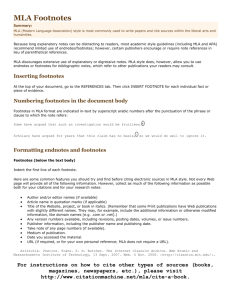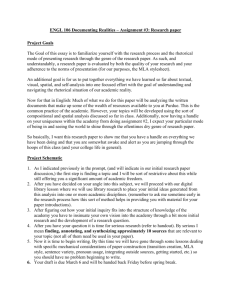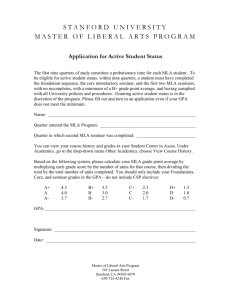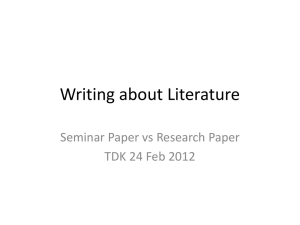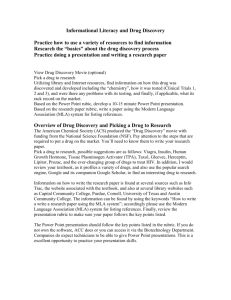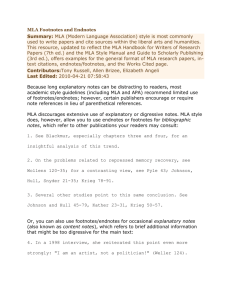MLA Formatting Expectations - Huber Heights City Schools
advertisement
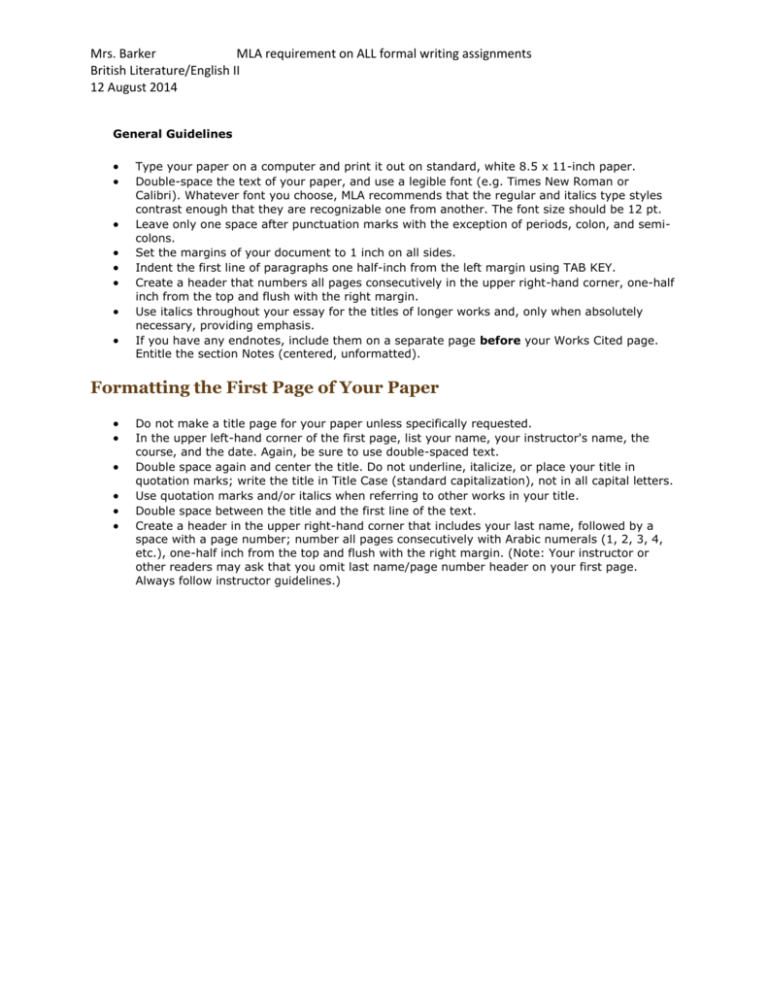
Mrs. Barker MLA requirement on ALL formal writing assignments British Literature/English II 12 August 2014 General Guidelines Type your paper on a computer and print it out on standard, white 8.5 x 11-inch paper. Double-space the text of your paper, and use a legible font (e.g. Times New Roman or Calibri). Whatever font you choose, MLA recommends that the regular and italics type styles contrast enough that they are recognizable one from another. The font size should be 12 pt. Leave only one space after punctuation marks with the exception of periods, colon, and semicolons. Set the margins of your document to 1 inch on all sides. Indent the first line of paragraphs one half-inch from the left margin using TAB KEY. Create a header that numbers all pages consecutively in the upper right-hand corner, one-half inch from the top and flush with the right margin. Use italics throughout your essay for the titles of longer works and, only when absolutely necessary, providing emphasis. If you have any endnotes, include them on a separate page before your Works Cited page. Entitle the section Notes (centered, unformatted). Formatting the First Page of Your Paper Do not make a title page for your paper unless specifically requested. In the upper left-hand corner of the first page, list your name, your instructor's name, the course, and the date. Again, be sure to use double-spaced text. Double space again and center the title. Do not underline, italicize, or place your title in quotation marks; write the title in Title Case (standard capitalization), not in all capital letters. Use quotation marks and/or italics when referring to other works in your title. Double space between the title and the first line of the text. Create a header in the upper right-hand corner that includes your last name, followed by a space with a page number; number all pages consecutively with Arabic numerals (1, 2, 3, 4, etc.), one-half inch from the top and flush with the right margin. (Note: Your instructor or other readers may ask that you omit last name/page number header on your first page. Always follow instructor guidelines.) Mrs. Barker MLA requirement on ALL formal writing assignments British Literature/English II 12 August 2014 Sample first page 31 March 2012 1” margin all around Mrs. Barker MLA requirement on ALL formal writing assignments British Literature/English II 12 August 2014 Parenthetical or in document citation One work and one author Wordsworth stated that Romantic poetry was marked by a "spontaneous overflow of powerful feelings" (263). Romantic poetry is characterized by the "spontaneous overflow of powerful feelings" (Wordsworth 263). Wordsworth extensively explored the role of emotion in the creative process (263). Two or more works and authors Smith, Yang, and Moore argue that tougher gun control is not needed in the United States (76). The authors state "Tighter gun control in the United States erodes Second Amendment rights" (Smith, Yang, and Moore 76). Two or more works by the same author Citing two articles by the same author: Lightenor has argued that computers are not useful tools for small children ("Too Soon" 38), though he has acknowledged elsewhere that early exposure to computer games does lead to better small motor skill development in a child's second and third year ("Hand-Eye Development" 17). Citing two books by the same author: Murray states that writing is "a process" that "varies with our thinking style" (Write to Learn 6). Additionally, Murray argues that the purpose of writing is to "carry ideas and information from the mind of one person into the mind of another" (A Writer Teaches Writing 3). Mrs. Barker MLA requirement on ALL formal writing assignments British Literature/English II 12 August 2014 Endnotes or Footnotes MLA discourages extensive use of explanatory or digressive notes. MLA style does, however, allow you to use endnotes or footnotes for bibliographic notes, which refer to other publications your readers may consult. The following are some examples: 1. See Blackmur, especially chapters 3 and 4, for an insightful analysis of this trend. 2. On the problems related to repressed memory recovery, see Wollens 120-35; for a contrasting view, see Pyle 43; Johnson, Hull, Snyder 21-35; Krieg 78-91. 3. Several other studies point to this same conclusion. See Johnson and Hull 4579, Kather 23-31, Krieg 50-57. Or, you can also use endnotes/footnotes for occasional explanatory notes (also known as content notes), which refers to brief additional information that might be too digressive for the main text: 4. In a 1998 interview, she reiterated this point even more strongly: "I am an artist, not a politician!" (Weller 124). Endnotes and footnotes in MLA format are indicated in-text by superscript arabic numbers after the punctuation of the phrase or clause to which the note refers: Some have argued that such an investigation would be fruitless.6 Scholars have argued for years that this claim has no basis,7 so we would do well to ignore it. Note that when a long dash appears in the text, the footnote/endnote number appearsbefore the dash: For years, scholars have failed to address this point8—a fact that suggests their cowardice more than their carelessness. Mrs. Barker MLA requirement on ALL formal writing assignments British Literature/English II 12 August 2014 Sample Works Cited: All information, author , if no author then title are to be in alphabetical order. Example shown below. Works Cited "Blueprint Lays Out Clear Path for Climate Action." Environmental Defense Fund. Environmental Defense Fund, 8 May 2007. Web. 24 May 2009. Clinton, Bill. Interview by Andrew C. Revkin. “Clinton on Climate Change.” New York Times. New York Times, May 2007. Web. 25 May 2009. Dean, Cornelia. "Executive on a Mission: Saving the Planet." New York Times. New York Times, 22 May 2007. Web. 25 May 2009. Ebert, Roger. "An Inconvenient Truth." Rev. of An Inconvenient Truth, dir. Davis Guggenheim. rogerebert.com. Sun-Times News Group, 2 June 2006. Web. 24 May 2009. GlobalWarming.org. Cooler Heads Coalition, 2007. Web. 24 May 2009. Gowdy, John. "Avoiding Self-organized Extinction: Toward a Co-evolutionary Economics of Sustainability." International Journal of Sustainable Development and World Ecology 14.1 (2007): 27-36. Print. An Inconvenient Truth. Dir. Davis Guggenheim. Perf. Al Gore, Billy West. Paramount, 2006. DVD. Leroux, Marcel. Global Warming: Myth Or Reality?: The Erring Ways of Climatology. New York: Springer, 2005. Print. Milken, Michael, Gary Becker, Myron Scholes, and Daniel Kahneman. "On Global Warming and Financial Imbalances." New Perspectives Quarterly 23.4 (2006): 63. Print. Nordhaus, William D. "After Kyoto: Alternative Mechanisms to Control Global Warming." American Economic Review 96.2 (2006): 31-34. Print. ---. "Global Warming Economics." Science 9 Nov. 2001: 1283-84. Science Online. Web. 24 May 2009. Shulte, Bret. "Putting a Price on Pollution." Usnews.com. US News & World Rept., 6 May 2007. Web. 24 May 2009. Uzawa, Hirofumi. Economic Theory and Global Warming. Cambridge: Cambridge UP, 2003. Print.


